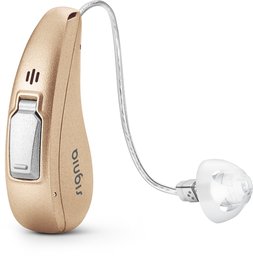 How Do Hearing Aids Help Us Hear Better? Hearing aids are electronic sound amplifiers that work similar to the way a microphone amplifies your voice when you speak into it. With the help of modern technology, however, hearing aids the size of a dime are able to incorporate a loudspeaker, amplifier, battery and microphone into one discreet package that fits in or over your ear. How Hearing Aids Work Sounds emerge as longitudinal waves in response to pressure variations within a specific medium, such as air or water. When an object vibrates, the air around it will also vibrate. If you are not wearing a hearing aid, the vibrations spreading outward from a vibrating object create sound waves that eventually reach your ears. The sound waves stimulate special hair cells that send the waves to your eardrum to make the eardrum vibrate rapidly. Nerves extending from your eardrum into the parietal lobe of your brain help the brain interpret sound waves as recognizable sounds. Analog Hearing Aids If you are wearing an analog hearing aid, the microphone inside the hearing aid will pick up sound waves and convert them into electrical currents or signals. Analog hearing aid amplifiers then increase the size of these electrical signals so you can hear them more clearly. Also called programmable hearing aids, analog hearing aids offer more than one volume setting so you can adjust to soft, loud or normal range sounds. Digital Hearing Aids Instead of converting sound waves into electrical signals, digital hearing aids convert them into numerical codes. You could compare these numerical codes to the binary code a computer needs to operate, except that converted sound wave codes contain information about the sound’s loudness or pitch. Digital hearing aids may also be programmed to detect sounds coming from specific directions instead of on all sounds coming from all directions.  What Material Are Hearing Aids Made Of? Hearing aid materials include acrylic, soft vinyl and silicone. Acrylic is a popular material because it facilitates insertion and removal of in-the-ear hearing aids and comes in hypoallergenic formulas. Although soft vinyl offers benefits for active children needing hearing aids, it tends to shrink and harden in time. Receiver-in-canal (RIC) and open-fit hearing aids are often made using soft vinyl because this material increases comfort level and works well as a retainer of receiver tubing coming from the hearing aid. For people with allergies to acrylic or soft vinyl, regular or “pure” silicon eliminates allergy issues and is almost as comfortable as soft vinyl. Hearing aids can also be fashioned out of polyethylene if the wearer is allergic to all other hearing aid materials. Leading Hearing Aid Manufacturers Pure Sound Hearing Aids provides superior quality hearing aids from virtually all of the country’s leading hearing manufacturers, such as Siemens, Oticon, Phonak, Resound, Starkey, Unitron, and many more. Call us today at to learn more about how to find the best hearing aid for your needs and how to receive your free hearing test.
0 Comments
Your comment will be posted after it is approved.
Leave a Reply. |
Categories
All
|
-
products
- Rexton Emerald M 8C RIC
- Rexton inoX CIC 8C
- Rexton Mosaic M 8C BTE
- Rexton Mosaic P 8C BTE
- Rexton Stellar RIC 8C
- Rexton Sterling 8C CIC / IIC
- Rexton Sterling 8C ITE / ITC
- Rexton Emerald XS 8C RIC
- Rexton Emerald S 8C RIC
- Signia Active Pro
- Signia CROS AX
- Signia CROS Hearing Solutions
- Signia Insio Charge&Go AX
- Signia Insio Nx IIC/CIC
- Signia Insio Nx ITC/ITE
- Signia Intuis 3 Family
- Signia Motion Charge&Go X
- Signia Motion 13 Nx/Motion 13 P Nx
- Signia Prompt
- Signia Pure Charge&Go AX & T AX
- Signia Pure 312 AX
- Signia Pure 10 Nx
- Signia Pure 13 BT
- Signia Pure 13 Nx
- Signia Silk X
- Signia Styletto AX
- Signia Styletto X
- SERVICES >
- about
- blog
- Insurance
- contact
|
© 2023 Pure Sound Hearing Aids. All Rights Reserved.
|
Proudly powered by Weebly
-
products
- Rexton Emerald M 8C RIC
- Rexton inoX CIC 8C
- Rexton Mosaic M 8C BTE
- Rexton Mosaic P 8C BTE
- Rexton Stellar RIC 8C
- Rexton Sterling 8C CIC / IIC
- Rexton Sterling 8C ITE / ITC
- Rexton Emerald XS 8C RIC
- Rexton Emerald S 8C RIC
- Signia Active Pro
- Signia CROS AX
- Signia CROS Hearing Solutions
- Signia Insio Charge&Go AX
- Signia Insio Nx IIC/CIC
- Signia Insio Nx ITC/ITE
- Signia Intuis 3 Family
- Signia Motion Charge&Go X
- Signia Motion 13 Nx/Motion 13 P Nx
- Signia Prompt
- Signia Pure Charge&Go AX & T AX
- Signia Pure 312 AX
- Signia Pure 10 Nx
- Signia Pure 13 BT
- Signia Pure 13 Nx
- Signia Silk X
- Signia Styletto AX
- Signia Styletto X
- SERVICES >
- about
- blog
- Insurance
- contact

 RSS Feed
RSS Feed